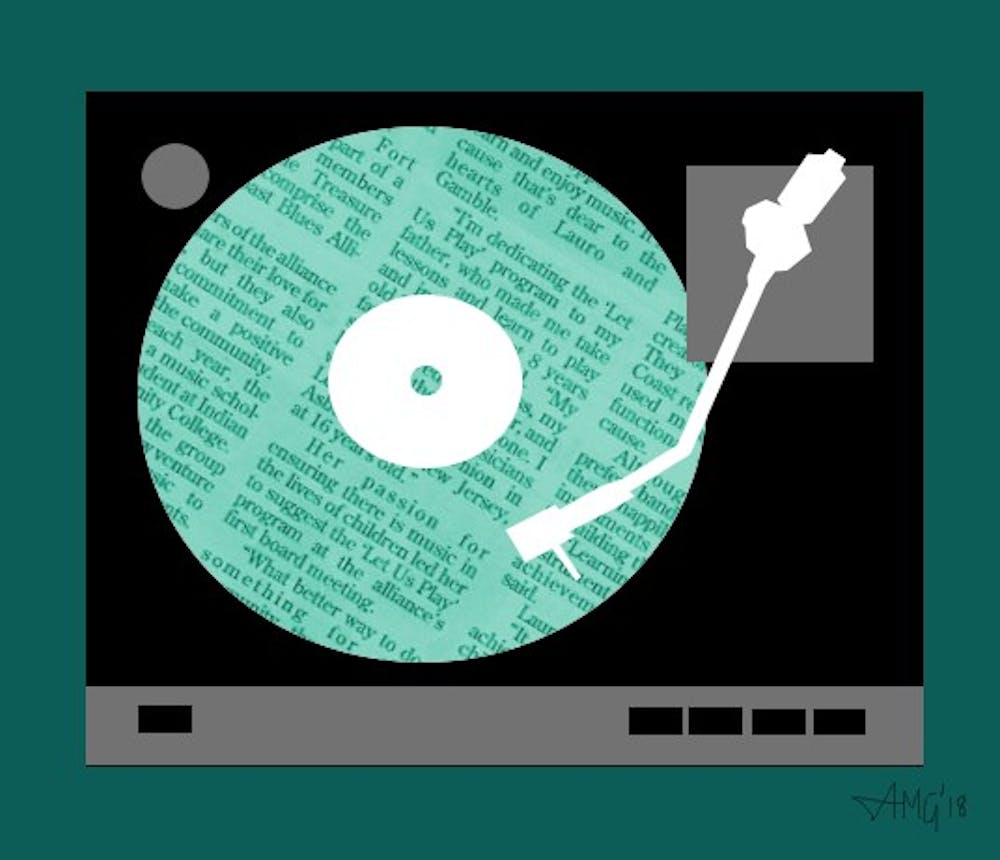I turned off my phone, tied back my hair, and rolled up my sleeves. Propping up my elbows, I arranged my hands into the familiar position had now become muscle memory. My fingers grazed over the sea of plastic packaging, filing through every album until one interrupted my steady flow of sorting.
Wedged in among her peers in category “Blues – D” sat Dinah Washington’s What a Diff’rence a Day Makes! I pulled it out of its place and turned it over in my hands, as my head filled with Dinah’s voice soaring mellifluously over silvery strings. At the chorus of the title track, I was transported out of the record store, out of Philadelphia, all the way back to August 2016 around a midnight campfire in Southwestern Pennsylvania, the flames illuminating my dad as he attempted to imbue me with his final words of wisdom before I left for college. But when that song came on, he stopped speaking, and we listened in tandem as Dinah’s voice merged with the echoing crickets around us.
I shook free from my daydream and promptly bought the record, with the bittersweet smell of that campfire still in my mind as I left.
The Numbers
In 2005, less than one million vinyl records were sold in the entire year. As of last July, 7.6 million vinyl albums had been sold in 2018, and sales reached a new high last April on the 10th annual celebration of Record Store Day. In the early wave of digital music, these antiques of a long–gone era sat collecting dust in the basements of America. But today they sit on display at mainstream outlets like Barnes & Noble or Urban Outfitters. These statistics are proof of vinyl’s undeniable comeback over the past decade.
Jack White, who topped off 2018’s mid–year vinyl sales with his latest album Boarding House Reach, is one of the leaders of vinyl resurgence with his independent record label, Third Man Records. In 2017, White was the keynote speaker at the first annual Making Vinyl Conference, which is set to take place again this October. In the interview from that conference, he spoke not only of sales numbers, but of anecdotal evidence of a vinyl comeback. “Last week I saw a TV show. I'm watching and there's a commercial for an insurance company and someone drops a needle on a vinyl record,” he said. “My kids are watching 'The Price Is Right' and they're giving away a turntable on 'The Price Is Right' in 2017!”
Local record stores here in Philadelphia like Long in the Tooth have seen a steady flow of customers over the past decade. Janis Devlin, who owns the Rittenhouse Square shop with her husband, says that they’ve been open for nearly thirteen years now, and have been more than able to keep up with the increasing rental rates in that area. Though most of their sales come from used records by artists who are no longer making music, she says that there’s been a noticeable trend of people buying music by small local artists as well.
Devlin agrees that there’s been a vinyl comeback recently, but she isn’t that surprised by it. “I think it’s happening now largely because people are listening to online music and it’s kind of detached,” she says. “So then you pick up a record and you can see art and liner notes, and it’s more organic, almost like an opposite.” Even if this uptick soon comes to an end, Devlin thinks it will keeping picking up in waves, noting that “records have always been a collector’s item like comic books. It goes up and down.”
Personal Collections
Devlin’s right. Many people interested in vinyl don’t casually own a couple of records. They collect them over time, saving up money for special editions, or trading a few bucks for a used niche soundtrack at a store whenever they see one.
Michael Nickley (C ‘20) first discovered vinyl through his brother, who introduced him to records when he was 15. Since then, he’s slowly amassed a bigger collection of vinyls that span across a variety of genres, including a special edition of the Journey video game soundtrack, a composer–signed copy of the La La Land soundtrack, and a 20th anniversary deluxe box set of Radiohead’s OK Computer.
Another of Penn’s serious vinyl connoisseurs is Nicole Almeida (C ‘19), an editor for Atwood Magazine, who agrees that one of the most fulfilling parts of collecting vinyl is finding rare or special recordings. As she talks about her favorite used record find, a rare seven–inch of “Tumbling Down” by Steve Harley & Cockney Rebel, it reminds her of another and another piece of her collection that she prizes just as much.
Since receiving her first record Let it Be as a birthday gift, she slowly began to accumulate vinyl from her favorite artists, though she still had no way of playing them. When Adele released 25 in the fall of 2015, Nicole remembers feeling so much love for the music that she needed to have it in every version possible. “I needed to hold it,” she says. From then on, she started seriously collecting on a regular basis, subscribing to VNYL, a service that sends its patrons a small collection of new vinyls each month based on a customizable taste profile.
The Listening Experience
Michael agrees that collecting vinyl can become an expensive hobby, especially since he prefers purchasing new records. But sometimes, he says, “it’s worth the investment,” citing his nearly $150 Radiohead box set as an example. His willingness to make this financial sacrifice comes down to the fact that he simply enjoys listening to his favorite albums on vinyl more than any other medium. “Everything is digital now, but listening to a record is a more active experience,” he says. “I enjoy interfacing with something more physical. It’s like talking to a person over the phone versus talking to them in person."
The ceremony of putting on a record seems to be a big part of the appeal for most vinyl collectors. “A lot about the way we listen to music has become more passive,” says Eli Newberger (E ‘20). “There’s a ritual and intentionality to vinyl that we’re missing in other forms.” In his vinyl collection, Eli has a few different versions of Vivaldi’s The Four Seasons—one that’s performed entirely on Japanese classical instruments, and another that’s an early '70s synthesizer version. For him, finding this niche music in a store is more exciting than typing it into a search bar on a streaming service, and as a result, his vinyl collection reflects a wider range of genres than most of his online choices do.
Eli’s favorite albums hold importance to him for both the music and the more sentimental memories and attachments they evoke. The physicality of records makes it easier to appreciate those connections, letting fans read liner notes or look at album art while the music plays. As he talks about the way Neil Young’s After the Gold Rush reminds him of driving to school in first grade with his dad, he pauses as if at a momentary loss for words before saying, “I can’t really do anything but sit and listen when I hear it.”
This idea of a tangible record holding a more profound meaning than a recording on a streaming service is one shared by almost everyone I speak to about vinyl. Michael, who loves the work that goes into the format of an album, thinks that records do a better job of expressing it, as record players make it extremely difficult to pause or skip tracks. Eli admires the permanence and commitment of them, a sentiment underlined by the fact that more and more artists go back and change or add tracks when the album is purely Internet–based. And Nicole feels that on occasion, vinyl can add a depth to the sound. In talking about her record of Marika Hackman’s We Slept at Last, she says “It’s warmer and deeper. I think the way that it sounds and fills up a room is how she meant for it to be.”
But Nicole believes in the power of vinyl for more than just a better listening experience. After working at record labels over the past couple of summers, she made connections with up–and–coming independent artists like QTY, a New York garage rock band that has been compared to the Strokes and the Velvet Underground. In fact, she was thanked in the dedication of the band’s 2017 debut, QTY.
Being close friends with an underground rock band trying to make a living has given Nicole an even deeper appreciation for the meaning of purchasing vinyl. “These artists spend years wanting to release an album, and then they have this final product and they can hold it and hug it,” she says. “Imagine that pride.” She now sees regularly purchasing vinyl as the best way to support these smaller artists, since Spotify is notorious for paying them so little.
Regardless of the many inspirations behind the purchases, people are buying more records today than they have for a long time. Even though these sales make up only a small fraction of revenue in the music industry, selling one vinyl record is more profitable than receiving a single stream of that album online for independent artists. Vinyl still remains a niche medium of listening to music, among the Penn student body and the world at large, but being the best way to support small artists, perhaps this undercurrent will give rise to another that will bring on the next generation of great music.







